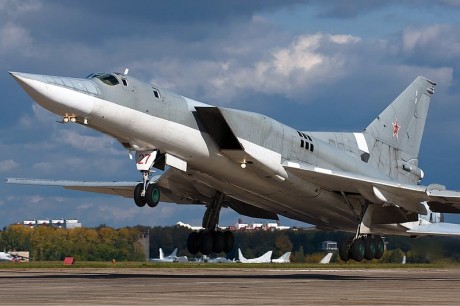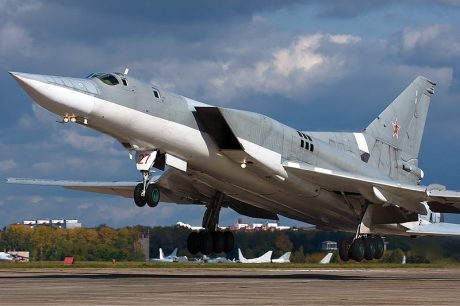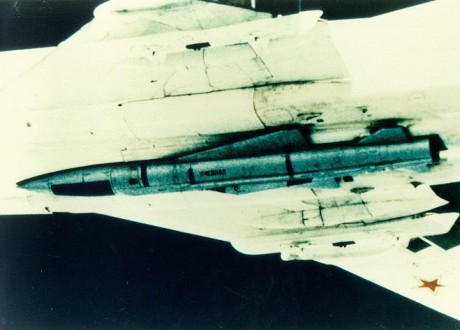As already happened in the past for other posts published on this blog, one the most interesting comment to The Aviationist’s recent article on China’s alleged purchase of the entire Tu-22 production line from Russia, has come from Aviationintel.com’s Tyler Rogoway.
Tyler has analyzed the controversial news for his excellent site and given his permission to share his perspective here for The Aviationist’s readers.
Why China’s Tu-22 bombers would represent a serious threat to U.S. Navy aircraft carriers
If, and I stress the if, this report [about the Tu-22 production line sale] proves true then China has just made yet another massive commitment toward its strategy of area denial vis-a-vis the US Navy and other smaller naval players in the region.
Some would think that China buying a relic like the Tu-22 does not represent much of a threat, especially when compared with modern low observable bombers and UAVs currently serving, or being tested, in the US. I disagree with this stance entirely.
The Backfire is a fantastically potent long-range anti-ship weapons platform that can also carry around plenty of other gear to do other missions, such as standoff or escort jamming, network relay, and long range radar targeting to name a few. When paired with the modern version of the KH-22/32, or similar indigenously developed supersonic anti-ship missile, with over a 300 mile range, the great utility of the Tu-22 to the Chinese Military is clear.
The Backfire will add a much-needed anti-access layer of defense against US Naval Carrier Strike Groups operating in the region.
China seeks to create a 1,000 mile buffer around its shores that will by and large keep American fighter aircraft and cruise missiles outside of striking range against strategic targets located on their mainland.
The Tu-22M, loaded with two to three KH-32 (or similar) anti-shipping missiles, has a true combat radius of about 1,500 miles. The anti-ship missiles themselves have a range of around 300 miles for supersonic anti-ship variants and up to 1,500 miles for subsonic anti-ship cruise missile variants. For this piece we will only talk about the shorter ranged supersonic anti-ship missiles as they pose a much greater threat to American naval flotillas than the lumbering long range subsonic variety.
Also, targeting becomes an issue with such a long range and slow flying missile capability.
The pairing of the Tu-22M and a KH-32 type of missile gives China a relevant and well established area denial buffer of about 1,900 miles. Thus putting US Carrier Strike Groups outside of their offensive striking distance by a factor of two for their Tomahawk land attack cruise missiles and over a factor of three for the F/A-18E/F and F-35C fleet.
So when it comes to inter-atmospheric anti-ship missile delivery, China has chosen a credible and commercially available weapons platform, and potentially its already integrated and developed weaponry, to get the job done. Furthermore, the swing-wing giant has considerable room for growth and weight reduction as it was built using 1970′s avionics and construction techniques. If modernized in terms of both its cockpit interface and sensors, as well as its propulsion and structures, the Tu-22 would remain as one of the best maritime standoff weapon systems in the world for the foreseeable future, a purpose configured aircraft focused on regional deterrence instead of offensive long-range strike.
Additionally the Tu-22 Backfire is fast, very fast (tops out at about M1.9 but can reach lower +1 mach numbers with ease). This means that once it launches its suicidal payload it can run like hell to avoid counter attack.
This is a big deal, as currently China’s archaic long range anti-shipping platforms are not high performance in nature, although they do possess superior range when compared with the Backfire (see Xian H-6).
All this comes down to a layered strategy of area denial being carefully constructed by the Chinese. There has been a ton of talk about their shadowy DF-21D “anti-ship ballistic missile” program over the last few years, a weapon system that China has already questionably declared operational. Still, I have heard no definitive information as to how accurate or even capable this system is at this stage of its development and clearly China lacks certain components which are very important in making the DF-21D an effective military capability (more on this later).
Regardless, America should not discount the ballistic anti-ship missile concept or its potential effectiveness. Even if it has a 15% success rate, this simply means that China will barrage our flotillas with a salvo of these carrier killers in an attempt to score a successful hit. The necessity of salvo attacks actually compounds the US Navy’s force protection and air defense problems as dealing with saturation attacks is still not their strong suit.
So does China’s claimed acquisition of a costly long-range, supersonic, air-breathing anti-ship missile delivery system with a lot of room for growth signal that their shadowy DF-21D program is still more of a dream than it is a reality?
Possibly, but I would rather classify China’s choice to procure the Tu-22M as one of common sense strategy and economic opportunity than a move to temporarily fulfill an unplanned strategic deficiency.
Adding a potent layer of area denial capability via the Tu-22 gives China redundancy when it comes to their naval anti-access strategy and clearly makes their potential naval foes in the region much more vulnerable to successful attack. To my knowledge, as it sits now, AEGIS ballistic missile defense ships cannot look for air-breathing and exo-atmospheric threats at the same time. This problem is solved by deploying to troubled regions with multiple AEGIS platforms that can split the duty up during high-risk phases of their mission. Still, this fact highlights the reality that a coordinated strike emanating from the air, inner space, and potentially underwater at a single time can cripple a Carrier Strike Group, especially if such an attack was made with large quantities of munitions.
All it takes is one “expendable” to hit its target to potentially leave a Carrier Strike Group without its primary offensive punch, the aircraft on the deck of the aircraft carrier that serves as its centerpiece. Additionally, an area denial / anti access (AD/A2) strategy is more about deterrence than anything else, so providing another clear reason not to sail within striking range of China’s shores during a time of peer state conflict undeniably strengthens China’s ability to deter such an incursion in the first place.
On the economic side of the equation, the Tu-22 has not been in production for over a decade and Russia will continue to draw down its aging air forces in exchange for modernization of remaining “legacy” platforms and for replacement of them by newer generation combat aircraft now coming online. In other words, metaphorically speaking, China bought an inventory and a factory that makes something nobody wants anymore.
Meanwhile, Russia is all about aggressive military exports and the peddling of its Cold War surplus inventory in exchange for fresh cash infusions whenever and wherever possible. So, in the case of the TU-22 the price was most likely very right and the requirement is clearly very real. In other words, the old adage “some deals just make themselves” is alive and well in the world of weapons exportation and proliferation, “one nation’s junk is another nation’s treasure” and so on…
We all know that China loves to reverse engineer pretty much anything they can get their hands on. Don’t hate the player, hate the game I guess. None-the-less, seeing as they are already building their own SU-27 derivatives, one of which is carrier capable, what is not to say that the technology gained by basically taking over the defunct Backfire program is not valuable to them in ways that are not totally clear to us at this time?
As I discussed earlier, if China develops the Tu-22 with new avionics, motors, subsystems and structures, they will have an incredibly powerful asset that can be used for many things, even as an air to air arsenal ship for ultra long-range air to air missiles, or as a heavy-duty jamming platform that can keep up with a formation of fighters for medium-range strike and counter air duties.
In essence, what China is getting buy purchasing not just a few dozen Tu-22s but the actual means of production and intellectual property related to the aircraft is a high performance asset that is uniquely suited for their geography and strategy, as well as technology transfer that can one day lead to the indigenous development of a much more advanced long range strike platform.
China has followed with a laser like focus the crawl-walk-run strategy when it comes to rapidly developing their indigenous aerospace and defense manufacturing capabilities, and the “crawling” and “walking” have mainly been done in “other nations shoes,” or in this case via technology transfer from the importation and eventual licensing of foreign high-end combat aircraft. This strategy has worked on a mind numbingly successful level, as China has gone from manufacturing MiG-21 derivatives to viable stealth fighters in a matter of a decade or so, so why would they depart from this proven model now when it comes to long range strike?
Like almost everything else AD/A2 related it all comes down to targeting. The ocean is a big, big place. Finding even a large US flotilla in it is like looking for a single human hair in a swimming pool. In order for the Backfire to accomplish its mission it needs to know where to go to attack, or even generally where to patrol in an attempt to search for targets. Currently, China’s DF-21D ballistic anti-ship missile system relies on over the horizon radar for targeting, whose accuracy and fidelity is questionable at best.
Additionally, these large fixed radar sites will be the first thing struck, even at great costs, in a war between China and the US. So, it primarily comes down to long endurance aircraft, ideally unmanned and low observable in nature, to provide key targeting info to any long-range maritime strike capability.
This is an area where China has lagged far behind the US, at least until we lost a RQ-170 Sentinel, in almost totally intact form, over Iran a year ago [please read this popular Aviationintel exclusive on this topic: http://aviationintel.com/2012/01/26/chinas-anti-ship-ballistic-missile-the-lost-rq-170-sentinel/], you may finish reading it with a totally new perspective on the “Sentinel Down” incident and its long-term repercussions).
In some ways, investing into a high-performance anti-ship strike force supports my theory that China’s number one technology of urgent need is wide area maritime surveillance of an unmanned variety, especially the type that has low potential for detection when it comes to its radar cross-section and electromagnetic emissions signature (low probability of intercept data-links and radar). America’s lost RQ-170 most likely gave China a large portion of the puzzle pieces they have desperately needed to begin developing such an enabling surveillance platform, and now they can prepare to capitalize on their dawning maritime targeting capability by supporting it with potent offensive weaponry like the Tu-22.
The Chinese Tu-22 story just further makes the case against America’s losing strategy of putting massive amounts of resources into short ranged low observable manned fighter aircraft.
We desperately need medium and long-range low observable strike platforms, preferably unmanned for the medium range force [please read this in depth Aviationintel analysis on the chronic need for a low observable long range weapons and sensor truck].
Additionally, we need to further invest into building up massive stocks of survivable standoff weaponry to be used in conjunction with these platforms as well as to give lower cost and highly reliable “legacy” platforms survivability during future wars. The pairing of standoff munitions with low observable long-range combat aircraft, especially ones with human beings at the controls, makes sense as risking these assets via flying directly into an enemy’s air defense umbrella during the opening stages of a campaign is lunacy.
As key integrated air defense components are destroyed using standoff weapons and low observable delivery platforms, these high value assets can push ever further into the enemy’s territory with a much better chances of survival than attacking directly at the beginning of hostilities while the enemy’s integrated air defense system is fully intact.
Once manned low observable aircraft can operate over the battlefield directly, affordable legacy platforms that possess shorter range, and rely on close proximity to vulnerable tanker aircraft, can begin hauling standoff weaponry to the edge of the enemy’s remaining air defense capabilities in an economical fashion. In the end, standoff weapons lowers the risk of losing near priceless long-range first day of war assets during the opening days of a conflict and keeps older and/or less expensive platforms relevant throughout the campaign.
The problem is that these advanced standoff munitions are not cheap, but they are much cheaper comparatively than procuring an all “first day of war” fighter force that does not even possess the range to strike an enemy using advanced AD/A2 tactics even when paired with such standoff weaponry. In many ways, when it comes to the modern era of air combat, the munitions make the mission, not their launch platform. There is only so much money to go around, so let’s invest heavier in standoff weaponry and a flexible “high-low” force structure instead of a one-size-fits all manned fighter jet with short range and a huge price tag.
What I am getting at here is that the F-35, especially the A and C models (at least the B model gives the USA 10 more “first day of war aircraft” carriers and can operate from dispersed staging areas), are a massive waste of money when it comes to our future strategic focus, that focus being China and the Pacific Theater.
The F-35 is wasteful jobs and export program dreamed up by fighter pilots with stars on their collars and ignorant politicians who hold the purse strings. It has little applicable utility to any of the wars we are fighting in today, or the ones we are likely to fight tomorrow.
For those of you who think this is a big leap from the Tu-22 narrative and that I have turned this somehow into a hit piece on the F-35, you are both wrong and right. You are wrong when it comes to discounting the validity of bringing up the F-35 “question” in relation to China’s supposed Tu-22 developments, and yes this is piece is now partially an F-35 hit job, and deservingly so.
Take the issue at hand, China deploying an upgraded version of the TU-22 Backfire, seeing as it can launch its deadliest payload some 300+ miles from the Carrier Strike Group it is targeting, and seeing as China would most likely stage such an attack using multiple aircraft pushing towards their launch points from different vectors, the F-35C does not have enough gas to maintain vigilance at that range from the carrier for a useful amount of time, thus the F-35C making it to these multiple event horizons and engaging the backfires with much likelihood of success a questionable proposition.
Now take a quartet of UCAVs, loaded with medium/long-range air to air missiles and low probability of intercept AESA radars. The UCAVs can individually loiter for hours in the “four corners” surrounding their Carrier Strike Group, at ranges in excess of 1000 miles, without being detected.
Now you have a way to neutralize the Tu-22 threat as whole, all in a cost-effective manner. Newsflash!: you do not need a 7.5G fighter jet to swat down a massive anti-ship missile toting bomber with a radar cross-section of a five-story building. To deny such a weapons platform the ability to launch of their targets you need persistence and range, neither of which the F-35 possesses.
In many ways, carrier based unmanned combat aircraft technology can work as its own area denial / anti-access weapon system via extended the view of the carrier group and encasing it in a protective screen that is sanitized from incoming threats.
For those threats that may leak through the outer omnipresent UCAV screen, traditional Super Hornets would be just as capable as the F-35 at defending the Carrier Strike Group’s “inner sanctum,” along with AEGIS cruisers and destroyers, as well as the Carrier’s own close in weapons systems and evolved Sea Sparrow missiles. It is all about reaching out as far as possible and denying an anti-ship missile toting aircraft like the Tu-22 the ability to launch, this is accomplished through range and presence, not high performance.
In the end, by the Navy focusing its dollars and developmental capacity on the F-35C they are choosing to leave our carrier groups more vulnerable than the high/low manned/unmanned alternative (Super Hornets and UCAVs), one that also represents the future of combat aviation (make sure to read my popular piece “Tyler’s 10 Thoughts On The Future Of Drone Warfare).
Furthermore, because the Navy continues with the F-35C program instead of more aggressively developing and procuring UCAVs they choose to limit our carrier’s direct striking distance to about 500 miles instead of over 1000 (unrefueled), all at greater human and thus political risk. In other words, the F-35C, and A for that matter, are a gift to the Chinese as it further enhances their AD/A2 fortress while sucking up funds that could be applied to more relevant longer range manned and unmanned low observable platforms and associated standoff weaponry.
The Chinese TU-22 story, if indeed true, is just another indication that we are choosing through misappropriation of resources to create a situation in the Pacific Theater where we are less capable of dealing a potential Chinese foe significant blows in light of their blooming AD/A2 strategy.
















